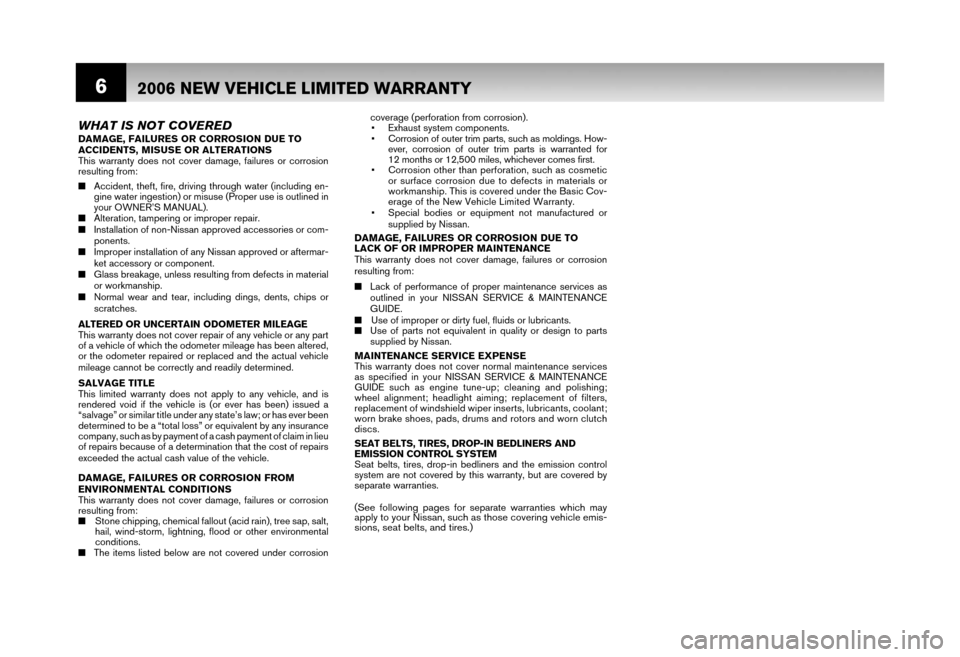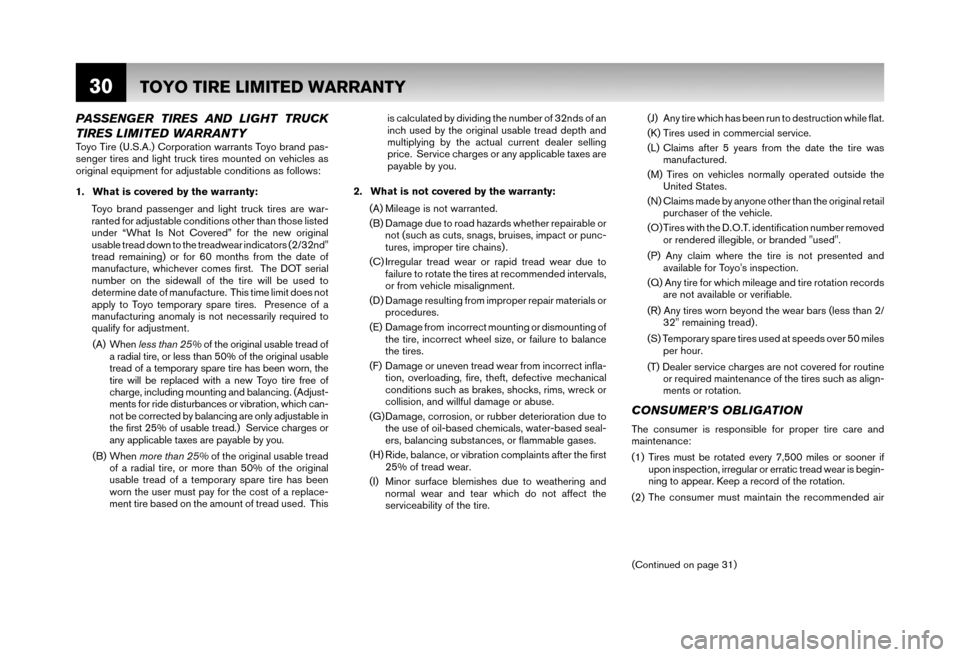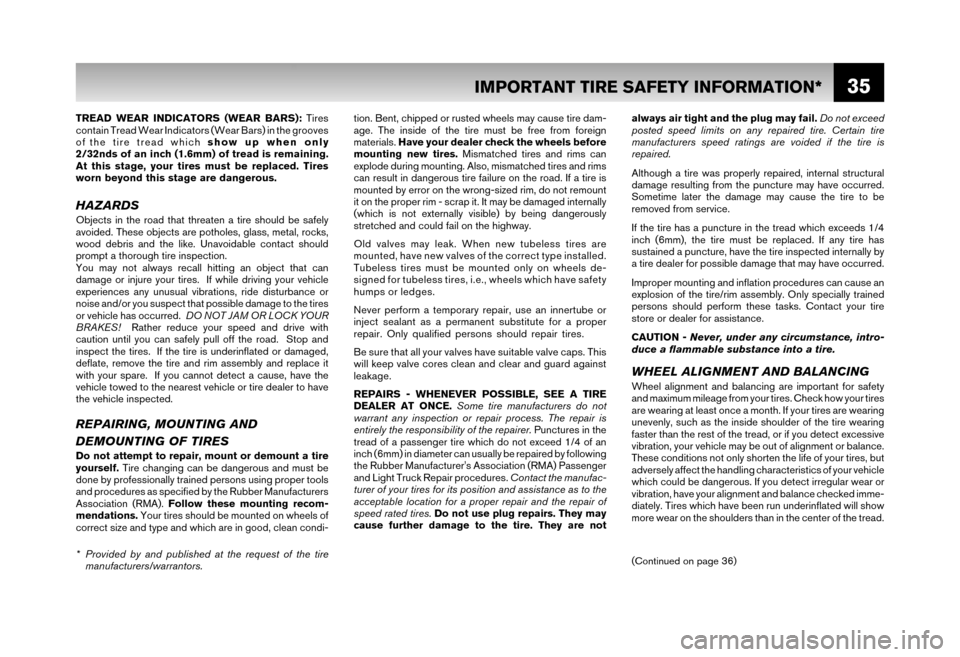2006 NISSAN MURANO brake light
[x] Cancel search: brake lightPage 11 of 55

62006 NEW VEHICLE LIMITED WARRANTY
WHAT IS NOT COVEREDDAMAGE, FAILURES OR CORROSION DUE TO
ACCIDENTS, MISUSE OR ALTERATIONS
This warranty does not cover damage, failures or corrosion
resulting from:
■ Accident, theft, fire, driving through water (including en-
gine water ingestion) or misuse (Proper use is outlined in
your OWNER’S MANUAL).
■ Alteration, tampering or improper repair.
■ Installation of non-Nissan approved accessories or com-
ponents.
■ Improper installation of any Nissan approved or aftermar-
ket accessory or component.
■ Glass breakage, unless resulting from defects in material
or workmanship.
■ Normal wear and tear, including dings, dents, chips or
scratches.
ALTERED OR UNCERTAIN ODOMETER MILEAGE
This warranty does not cover repair of any vehicle or any part
of a vehicle of which the odometer mileage has been altered,
or the odometer repaired or replaced and the actual vehicle
mileage cannot be correctly and readily determined.
SALVAGE TITLE
This limited warranty does not apply to any vehicle, and is
rendered void if the vehicle is (or ever has been) issued a
“salvage” or similar title under any state’s law; or has ever been
determined to be a “total loss” or equivalent by any insurance
company, such as by payment of a cash payment of claim in lieu
of repairs because of a determination that the cost of repairs
exceeded the actual cash value of the vehicle.
DAMAGE, FAILURES OR CORROSION FROM
ENVIRONMENTAL CONDITIONS
This warranty does not cover damage, failures or corrosion
resulting from:
■ Stone chipping, chemical fallout (acid rain), tree sap, salt,
hail, wind-storm, lightning, flood or other environmental
conditions.
■ The items listed below are not covered under corrosion coverage (perforation from corrosion).
• Exhaust system components.
• Corrosion of outer trim parts, such as moldings. How- ever, corrosion of outer trim parts is warranted for
12 months or 12,500 miles, whichever comes first.
• Corrosion other than perforation, such as cosmetic or surface corrosion due to defects in materials or
workmanship. This is covered under the Basic Cov-
erage of the New Vehicle Limited Warranty.
• Special bodies or equipment not manufactured or
supplied by Nissan.
DAMAGE, FAILURES OR CORROSION DUE TO
LACK OF OR IMPROPER MAINTENANCE
This warranty does not cover damage, failures or corrosion
resulting from:
■ Lack of performance of proper maintenance services as
outlined in your NISSAN SERVICE & MAINTENANCE
GUIDE.
■ Use of improper or dirty fuel, fluids or lubricants.
■ Use of parts not equivalent in quality or design to parts
supplied by Nissan.
MAINTENANCE SERVICE EXPENSE
This warranty does not cover normal maintenance services
as specified in your NISSAN SERVICE & MAINTENANCE
GUIDE such as engine tune-up; cleaning and polishing;
wheel alignment; headlight aiming; replacement of filters,
replacement of windshield wiper inserts, lubricants, coolant;
worn brake shoes, pads, drums and rotors and worn clutch
discs.
SEAT BELTS, TIRES, DROP-IN BEDLINERS AND
EMISSION CONTROL SYSTEM
Seat belts, tires, drop-in bedliners and the emission control
system are not covered by this warranty, but are covered by
separate warranties.
(See following pages for separate warranties which may
apply to your Nissan, such as those covering vehicle emis-
sions, seat belts, and tires.)
Page 35 of 55

30
PASSENGER TIRES AND LIGHT TRUCK
TIRES LIMITED WARRANTY
Toyo Tire (U.S.A.) Corporation warrants Toyo brand pas-
senger tires and light truck tires mounted on vehicles as
original equipment for adjustable conditions as follows:
1. What is covered by the warranty:
Toyo brand passenger and light truck tires are war-
ranted for adjustable conditions other than those listed
under “What Is Not Covered” for the new original
usable tread down to the treadwear indicators (2/32nd"
tread remaining) or for 60 months from the date of
manufacture, whichever comes first. The DOT serial
number on the sidewall of the tire will be used to
determine date of manufacture. This time limit does not
apply to Toyo temporary spare tires. Presence of a
manufacturing anomaly is not necessarily required to
qualify for adjustment. (A) When less than 25% of the original usable tread of
a radial tire, or less than 50% of the original usable
tread of a temporary spare tire has been worn, the
tire will be replaced with a new Toyo tire free of
charge, including mounting and balancing. (Adjust-
ments for ride disturbances or vibration, which can-
not be corrected by balancing are only adjustable in
the first 25% of usable tread.) Service charges or
any applicable taxes are payable by you.
(B) When more than 25% of the original usable tread
of a radial tire, or more than 50% of the original
usable tread of a temporary spare tire has been
worn the user must pay for the cost of a replace-
ment tire based on the amount of tread used. This is calculated by dividing the number of 32nds of an
inch used by the original usable tread depth and
multiplying by the actual current dealer selling
price. Service charges or any applicable taxes are
payable by you.
2. What is not covered by the warranty: (A) Mileage is not warranted.
(B) Damage due to road hazards whether repairable or not (such as cuts, snags, bruises, impact or punc-
tures, improper tire chains) .
(C) Irregular tread wear or rapid tread wear due to failure to rotate the tires at recommended intervals,
or from vehicle misalignment.
(D) Damage resulting from improper repair materials or procedures.
(E) Damage from incorrect mounting or dismounting of the tire, incorrect wheel size, or failure to balance
the tires.
(F) Damage or uneven tread wear from incorrect infla- tion, overloading, fire, theft, defective mechanical
conditions such as brakes, shocks, rims, wreck or
collision, and willful damage or abuse.
(G) Damage, corrosion, or rubber deterioration due to the use of oil-based chemicals, water-based seal-
ers, balancing substances, or flammable gases.
(H) Ride, balance, or vibration complaints after the first 25% of tread wear.
(I) Minor surface blemishes due to weathering and normal wear and tear which do not affect the
serviceability of the tire. (J) Any tire which has been run to destruction while flat.
(K) Tires used in commercial service.
(L) Claims after 5 years from the date the tire was
manufactured.
(M) Tires on vehicles normally operated outside the United States.
(N) Claims made by anyone other than the original retail purchaser of the vehicle.
(O) Tires with the D.O.T. identification number removed or rendered illegible, or branded "used".
(P) Any claim where the tire is not presented and available for Toyo's inspection.
(Q) Any tire for which mileage and tire rotation records are not available or verifiable.
(R) Any tires worn beyond the wear bars (less than 2/ 32" remaining tread) .
(S) Temporary spare tires used at speeds over 50 miles per hour.
(T) Dealer service charges are not covered for routine or required maintenance of the tires such as align-
ments or rotation.
CONSUMER’S OBLIGATION
The consumer is responsible for proper tire care and
maintenance:
(1) Tires must be rotated every 7,500 miles or sooner if upon inspection, irregular or erratic tread wear is begin-
ning to appear. Keep a record of the rotation.
(2) The consumer must maintain the recommended air
TOYO TIRE LIMITED WARRANTY
(Continued on page 31)
Page 40 of 55

35
TREAD WEAR INDICATORS (WEAR BARS): Tires
contain Tread Wear Indicators (Wear Bars) in the grooves
of the tire tread which show up when only
2/32nds of an inch (1.6mm) of tread is remaining.
At this stage, your tires must be replaced. Tires
worn beyond this stage are dangerous.
HAZARDSObjects in the road that threaten a tire should be safely
avoided. These objects are potholes, glass, metal, rocks,
wood debris and the like. Unavoidable contact should
prompt a thorough tire inspection.
You may not always recall hitting an object that can
damage or injure your tires. If while driving your vehicle
experiences any unusual vibrations, ride disturbance or
noise and/or you suspect that possible damage to the tires
or vehicle has occurred. DO NOT JAM OR LOCK YOUR
BRAKES! Rather reduce your speed and drive with
caution until you can safely pull off the road. Stop and
inspect the tires. If the tire is underinflated or damaged,
deflate, remove the tire and rim assembly and replace it
with your spare. If you cannot detect a cause, have the
vehicle towed to the nearest vehicle or tire dealer to have
the vehicle inspected.
REPAIRING, MOUNTING AND
DEMOUNTING OF TIRES
Do not attempt to repair, mount or demount a tire
yourself. Tire changing can be dangerous and must be
done by professionally trained persons using proper tools
and procedures as specified by the Rubber Manufacturers
Association (RMA). Follow these mounting recom-
mendations. Your tires should be mounted on wheels of
correct size and type and which are in good, clean condi- tion. Bent, chipped or rusted wheels may cause tire dam-
age. The inside of the tire must be free from foreign
materials.
Have your dealer check the wheels before
mounting new tires. Mismatched tires and rims can
explode during mounting. Also, mismatched tires and rims
can result in dangerous tire failure on the road. If a tire is
mounted by error on the wrong-sized rim, do not remount
it on the proper rim - scrap it. It may be damaged internally
(which is not externally visible) by being dangerously
stretched and could fail on the highway.
Old valves may leak. When new tubeless tires are
mounted, have new valves of the correct type installed.
Tubeless tires must be mounted only on wheels de-
signed for tubeless tires, i.e., wheels which have safety
humps or ledges.
Never perform a temporary repair, use an innertube or
inject sealant as a permanent substitute for a proper
repair. Only qualified persons should repair tires.
Be sure that all your valves have suitable valve caps. This
will keep valve cores clean and clear and guard against
leakage.
REPAIRS - WHENEVER POSSIBLE, SEE A TIRE
DEALER AT ONCE. Some tire manufacturers do not
warrant any inspection or repair process. The repair is
entirely the responsibility of the repairer. Punctures in the
tread of a passenger tire which do not exceed 1/4 of an
inch (6mm) in diameter can usually be repaired by following
the Rubber Manufacturer's Association (RMA) Passenger
and Light Truck Repair procedures. Contact the manufac-
turer of your tires for its position and assistance as to the
acceptable location for a proper repair and the repair of
speed rated tires. Do not use plug repairs. They may
cause further damage to the tire. They are not always air tight and the plug may fail.
Do not exceed
posted speed limits on any repaired tire. Certain tire
manufacturers speed ratings are voided if the tire is
repaired.
Although a tire was properly repaired, internal structural
damage resulting from the puncture may have occurred.
Sometime later the damage may cause the tire to be
removed from service.
If the tire has a puncture in the tread which exceeds 1/4
inch (6mm), the tire must be replaced. If any tire has
sustained a puncture, have the tire inspected internally by
a tire dealer for possible damage that may have occurred.
Improper mounting and inflation procedures can cause an
explosion of the tire/rim assembly. Only specially trained
persons should perform these tasks. Contact your tire
store or dealer for assistance.
CAUTION - Never, under any circumstance, intro-
duce a flammable substance into a tire.
WHEEL ALIGNMENT AND BALANCINGWheel alignment and balancing are important for safety
and maximum mileage from your tires. Check how your tires
are wearing at least once a month. If your tires are wearing
unevenly, such as the inside shoulder of the tire wearing
faster than the rest of the tread, or if you detect excessive
vibration, your vehicle may be out of alignment or balance.
These conditions not only shorten the life of your tires, but
adversely affect the handling characteristics of your vehicle
which could be dangerous. If you detect irregular wear or
vibration, have your alignment and balance checked imme-
diately. Tires which have been run underinflated will show
more wear on the shoulders than in the center of the tread.
* Provided by and published at the request of the tire manufacturers/warrantors.
IMPORTANT TIRE SAFETY INFORMATION*
(Continued on page 36)